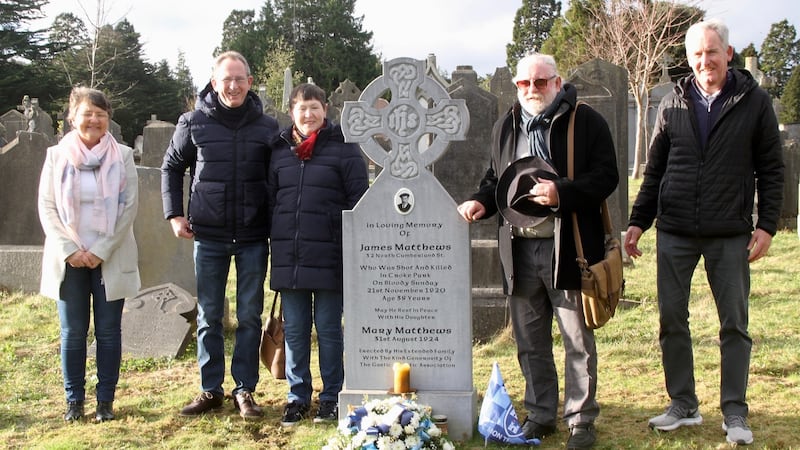The 14 civilians killed or fatally injured at Croke Park on Bloody Sunday were remembered at a ceremony at the stadium on Saturday, 100 years after their deaths.
In contrast to the maelstrom and bloodshed of the day in 1920, Croke Park was silent and cast into darkness for the ceremony, which preceded the Dublin-Meath Leinster Senior Football Championship final.
It was a cool, still evening without a breath of wind around the stadium, and a half moon hung over the Canal End.
For too long Michael Hogan, the Tipperary footballer who gave his name to the Hogan Stand, was the only name of those killed that day 100 years ago to be remembered. The others were an anonymous, amorphous group of victims.
There was no hierarchy of remembrance on Saturday night, however. Instead, the names of the 14 who died were read out in alphabetical order, beginning with Jane Boyle, a butcher's assistant, who was due to get married that week and was buried in her wedding dress, and ending with Joe Traynor, the football-mad captain of the Young Emmets team in Inchicore who died when a bullet entered his back.
As each name was read out, a torch was lit at the corner of Hill 16 and the Canal End and a beam of light was cast into the skies over Croke Park.
The site of the wreathlaying was the spot where Michael Hogan was shot dead.
In the parallel universe that used to be our normal lives, the centenary of Bloody Sunday was supposed to coincide with the second international rules test between Ireland and Australia, with a packed house in attendance.
Instead, it was the emptiness that stood out, as Taoiseach Micheál Martin and President Michael D Higgins laid wreathes.
Actor Brendan Gleeson, reading from a script prepared by Michael Foley, the author of The Bloodied Field, recalled a sunny Sunday 100 years ago when 15,000 people turned up for a match at a time of war when such occasions were a rare thing.
At 3.25pm bullets skimmed the turf and bullets sparked off the wall as people fell, having been shot or crushed to death.
“In 90 seconds 14 people lay dead or mortally wounded on the fields and banks of Croke Park and in the streets outside,” he recalled.
“They are our family, our friends, our people. We remember them all.”
Graveside remembrance
Earlier in the day the relatives of one of the victims, James Matthews, remembered him at his graveside in Glasnevin Cemetery.
Mr Matthews (38) was from a tenement in North Cumberland Street in Dublin. He was married and had four daughters.
As was the case for many who were shot on that day, his family did not have the means to erect a headstone, and he lay unmarked, and for the most part unremembered, until the GAA’s Bloody Sunday project erected a headstone over his grave in 2016.
His then 95-year-old daughter Nancy attended that unveiling and paid a silent tribute to the father she never knew. Her mother was three months’ pregnant with her on Bloody Sunday.
Nancy died at the age of 97 in 2018 and is buried in Glasnevin Cemetery near her father.
On the 100th anniversary of James's death, members of his extended family visited his grave. His grandsons John, Martin and James Lynch were in attendance. They laid a wreath in the Dublin colours and placed a Dublin GAA flag beside it.
The visit coincided with an announcement by the Abbey Theatre that a bursary has been created in the name of James Matthews to allow an artist to reimagine his life and death.

James Matthews was hit while trying to flee Croke Park during the shooting. He was shot as he attempted to scale a wall out of the grounds and died later from haemorrhagic shock.
“In normal circumstances we would have been in Croke Park,” said James Lynch, who is named after him. “It is great that we have an actual grave to visit.
“For my grandfather it was a normal Sunday and it ended in tragedy. The impact on our family was horrendous.”
Dawn ceremony
James Burke (44), another one of those who died after crown forces opened fire on Bloody Sunday, was remembered at a dawn ceremony at the Ballinteer St Johns GAA club in south Dublin.
The Tricolour and the flags of Dublin and Tipperary were raised at dawn and lowered at 3pm by the grandsons and great-grandsons of Mr Burke, a father of five. The granite base of his headstone will be moved to the club grounds into perpetuity.
In a statement to mark Bloody Sunday, British ambassador Paul Johnston said it was a "day for reflection". He also echoed the words of Queen Elizabeth II when she visited Ireland in 2011: "To all those who have suffered as a consequence of our troubled past I extend my sincere thoughts and deep sympathy. With the benefit of historical hindsight we can all see things which we would wish had been done differently or not at all."
Mr Johnston, who was not invited to the ceremony at Croke Park, said there will be many opportunities to “reflect on the complex and difficult past” in the coming years.



















